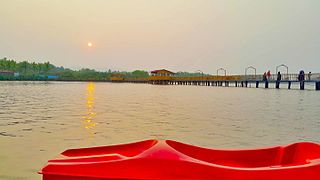
Kannur is one of the 14 districts along the west coast in the state of Kerala, India. The city of Kannur is the district headquarters and gives the district its name. The old name, Cannanore, is the anglicized form of the Malayalam name "Kannur". Kannur district is bounded by Kasaragod District to the north, Kozhikode district to the south, Mahé district to the southwest and Wayanad District to the southeast. To the east, the district is bounded by the Western Ghats, which forms the border with the state of Karnataka. The Arabian Sea lies to the west. Paithalmala is the highest point in Kannur District (1,372m). Enclosed within the southern part of the district is the Mahé district of the Union Territory of Puducherry. The district was established in 1957.
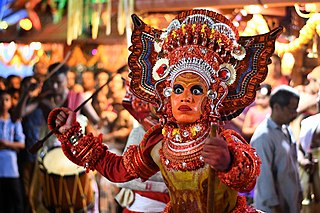
Theyyam is a popular ritual form of dance worship in Kerala and Karnataka, India. Theyyam consisted of thousand-year-old traditions, rituals and customs. The people of these districts consider Theyyam itself as a channel to a god and they thus seek blessings from Theyyam.

The Tulu people or Tuluva people are an ethno- linguistic group native to Southern India. They are native speakers of the Tulu language and the region they traditionally inhabit is known as Tulu Nadu. This region comprises the districts of Dakshina Kannada and Udupi in Karnataka and a part of Kasaragod district in Kerala, with Mangalore, Karnataka being the commercial hub. The Census report of 2011 reported a population of 1,846,427 native Tulu speakers living in India.

Parassinikadavu Muthappan temple is a temple, located at Parassinikadavu in Anthoor Municipality on the banks of the Valapattanam river about 10 km from Taliparambu and 16 km from Kannur City in Kannur District, Kerala, India. Principal deity of the temple is Sree Muthappan, whose divinity is presented as a ritualistic theyyam enactment in two versions called Thiruvappan and Vellattam. According to the local tradition the presiding deity is a manifestation of Lord Shiva.

Muthappan is a deity commonly worshiped in the Kannur, Kasargod, Kozhikode, Malapuram region of Kerala and Coorg region of Karnataka in India. Muthappan is considered as the personification of two Hindu gods — the Thiruvappan or Valiya Muttapan (Vishnu) and the Vellatom or Cheriya Muttapan (Shiva).
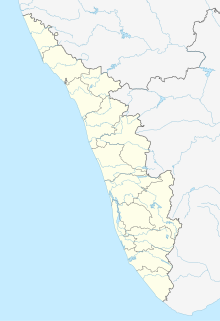
Kunnathur Padi is the historic center for the folk Hindu deity Sree Muthappan. The center stands in Payyavoor Grama Panchayat, Kannur District of the Kerala state of India, 3,000 feet above sea level, on top of Udumbumala in the Sahyadri mountains.

Edakkad is part of the Kannur Municipal Corporation in Kannur District of Kerala state, in India.
Edacheri is a small panchayath in the district of Kozhikode in the South Indian state of Kerala.

Kannapurampronunciation (help·info) is a census town in Kannur district of North Malabar region in the Indian state of Kerala.
Keyi, are one of the several denominations among Muslims of Kerala, India. The Keyis are known for their immense wealth and land properties acquired through trade with the English East India Company. The Keyi family has its roots in Thalassery, Kannur district. Keyis only marry from another Keyi family and are noted for their matrilinear system of inheritance.

Islam arrived in Kerala, the Malayalam-speaking region in the south-western tip of India, through Middle Eastern merchants. The Indian coast has an ancient relation with West Asia and the Middle East, even during the pre-Islamic period.

Cherupuzha is a town in Kannur district, Kerala, India. It is the headquarters of the Cherupuzha Panchayat which is a special grade panchayat in Kerala.

North Malabar refers to the geographic area of southwest India covering the state of Kerala's present day Kasaragod, Kannur, and Wayanad districts, and the taluks of Vatakara, Koyilandy, and Thamarassery in the Kozhikode District of Kerala and the entire Mahé Sub-Division of the Union Territory of Puducherry. Traditionally North Malabar is defined as the northern portion of erstwhile Malabar District which lies between Chandragiri River and Korapuzha River. The region between Netravathi River and Chandragiri River, which included the portions between Mangalore and Kasaragod, are also often included in the term North Malabar, as the Kumbla dynasty in the southernmost region of Tulu Nadu, had a mixed lineage of Malayali Nairs and Tuluva Brahmins.
There are places of worship considered important in the Kannur district. Kannur District is one of the 14 districts in the state of Kerala, India. The town of Kannur is the district headquarters, and gives the district its name.

Orkkatteri is a small town in Kozhikode district in the North Malabar region of state of Kerala, India. This is the center town for Eramala grama panchayath.
Madayi Mosque is mosque at Pazhayangadi in Kannur district, northern Kerala. It is one of the oldest mosques in Kerala, with local legends dating back to 7th century AD. It is believed to have been established by Malik ibn Dinar and contains a block of white marble said to have been brought from Mecca by ibn Dinar. It is one of the several mosques around Pazhayangadi/Payangadi. It is situated on the banks of Kuppam River, which joins Valapattanam River at its estuary.
Kozhikode has been a multi-ethnic and multi-religious town since the early medieval period. The Hindus forms the largest religious group, followed by Muslims and Christians. Hindus form the majority at 57.7% with 315807 members of the total population. Muslims form 37.6% with 207298 members of the total population.
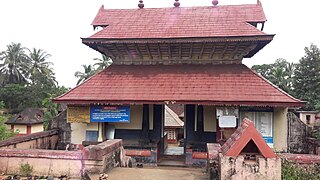
Sree Madiyan Koolom Temple is located near Kanhangad in the Indian state of Kerala. It is one of the most prominent Hindu temples in Kasargod district, and is some 500 years old. It is dedicated to deity Kshetrapalakan Eswaran, the mother Goddess known as Kalarathri Amma (Bhadrakali).
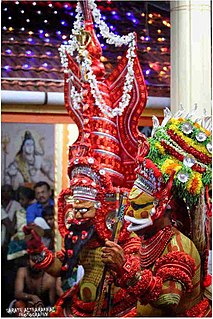
Altharakkal Sree Muthappan Madapura is a temple, located at Pullur Village about 6.2 km from Kanhangad City and 25 km from Kasaragod City in Kasaragod District, Kerala. Principal deity of the temple is Sree Muthappan, whose divinity is presented as a ritualistic theyyam enactment in two versions called Thiruvappana and Vellattam. According to the local tradition the presiding deity is a manifestation of Lord Shiva.

Kathivanoor Veeran is a deity worshiped in North Malabar region in Kerala, India. The word 'Veeran' in Malayalam means 'Hero' in English. According to the myths, Kathivanoor Veeran is apotheosis of Thiyya warrior Mandappan. Mandappan's life and his transformation into god are still active in the folklore of Kolathunadu region, and is practiced as theyyam in various temples in present-day Kannur and Kasaragod districts. Kathivanoor Veeran Theyyam is one of the most popular Theyyams in North Malabar. Girls of North Malabar region worship Kathivanoor Veeran to get a healthy husband.













